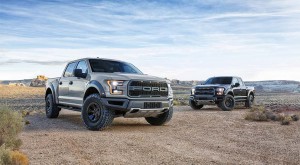
Not even the F-Series could save Ford's sales in September: the trucks were down 3% while Ford was down 7.7%.
Sales of new vehicles remained flat during September as domestic manufacturers, General Motors Co., Ford Motor Co. and Fiat Chrysler Automobiles N.V., reported sales decreases as Japanese rivals posted modest increases for the month.
Ford was one of the biggest losers reporting an 7.7% drop in sales. Even sales of the F-Series pickup trucks fell.
“We continue seeing strong customer demand, especially for vans and pickup trucks, including our all-new Super Duty,” said Mark LaNeve, Ford vice president, U.S. Marketing, Sales and Service.
“Demand for a rich mix of our all-new Super Duty pickups helped boost Ford’s average transaction prices by $1,100 versus a year ago, outpacing the industry’s $400 average.”
September marked this year’s best month for F-Series’ retail sales, LaNeve noted, but Ford F-Series sales totaled 67,809 vehicles, a 3% decline.
FCA US LLC reported a 1% decrease compared with sales in September. Retail sales represented 76% of total sales, while fleet sales were 24%.
However, FCA showed strength in key areas last month. The Ram Truck brand posted a 27% sales gain in September compared with the same month a year ago as pickup truck sales increased 29% year over year. Both the Dodge Charger and Dodge Challenger turned in double-digit percentage increases in September while the Jeep Grand Cherokee posted an 18% sales gain.
Sales of the all-new 2017 Chrysler Pacifica minivan increased 23% in September, versus sales in the previous month of August. Sales of the all-new 2017 Fiat 124 Spider, the latest addition to the Fiat brand product line-up, were up 7% compared with August sales.
(Could Renault-Nissan top Toyota for global sales crown in 2017? Click Here to find out.)
GM said its sales slipped by less than 1% during September as it continued pulling back sales to rental fleets.
“GM again outperformed the retail industry and gained profitable market share. We continue to lead the retail truck industry and gained share in the two largest car segments,” said Kurt McNeil, GM’s vice president of U.S. sales operations.
“We are achieving these results while maintaining disciplined incentive spending and commanding the industry’s best average transaction prices for any full-line manufacturer,” he added.
GM’s ATPs, which reflect retail transaction prices after sales incentives, were $35,804 in September, approximately $1,000 above last September’s performance, McNeil noted.
GM continues to benefit from a strong U.S. economy.
“Key economic fundamentals like a strong jobs market, rising personal incomes, low fuel prices and low interest rates continue to point toward strong industry performance,” said Mustafa Mohatarem, GM’s chief economist. “We think the industry is well positioned for a continued high level of customer demand into the foreseeable future,” he said.
(Click Here to find out more about how fighting car hackers is going to be big business.)
American Honda Motor Co. Inc. also reported a very small sales drop of 0.1% decrease from September 2015. American Honda trucks set a new September record, gaining 8.5% on sales of 69,069 units. The Honda Division also set a new September mark, gaining 1.5%.
Toyota reported a 1.5% sales increases as its passenger cars such as the Corolla and Camry continued to sell well despite the continuing surge in truck sales, which analysts now expect to account for roughly 61% of all new vehicles sold in the U.S.
Nissan also enjoyed a strong month in September as sales grew by 5% on strong sales of trucks, sport utility vehicle and crossovers.
Volkswagen also scored something of a victory in September as sales dropped by only .5% in September. Audi reported a 1.5% sales increase.
Kelley Blue Book estimated that the average transaction price for light vehicles in the United States was $34,372 in September 2016. New-car prices have increased by $823 up 2.5% from September 2015, while falling $82 or 0.2% from the previous level in August.
“Much of the automotive industry’s focus recently has been on rising incentives and very little sales growth, however average transaction prices continue to rise across the industry, climbing nearly 3% in September 2016 from the previous year,” said Tim Fleming, analyst for Kelley Blue Book.
(To see more about how fuel economy numbers are going to take a hit, Click Here.)
“This trend has been bolstered by the shift in consumer preference from cars to crossovers and SUVs. Midsize trucks also stand out as a segment on the rise, with sales up double digits and transaction prices rising nearly 6% on average to $32,350,” he said.

